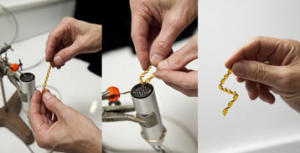
Privacy statement: Your privacy is very important to Us. Our company promises not to disclose your personal information to any external company with out your explicit permission.
Select Language

A common feature of windsurfing, aircraft, and electronic circuits is that they all contain resins that are lightweight, strong, and highly resistive. However, once hardened, these resins can no longer be remodeled. Until now, only certain inorganic compounds, including glass, have this property. It seems impossible to combine such attributes in a single material. Now, a research team has developed a new compound with such extraordinary attributes. The leader of the research team is Ludwik Rebler ( Ludwik Leibler) is a researcher at CNRS and ESPCI ParisTech's Laboratoire Matière Molle et Chimie. This new type of material can be repaired as well as recycled. At high temperatures, it can be shaped and reversed.
This set of figures shows how to sequentially deform and heat to make a complex shape object.
And, quite surprisingly, some of the properties it retains are also unique to organic resins and rubber: it is light, insoluble, and not easily broken. Because of its low cost and ease of production, this material can be used in many industrial fields, especially in the automotive, aerospace, construction, electronics and leisure fields. This study was published in Science on November 18, 2011.
Substituting metals for lighter but equally efficient materials is necessary in many industries such as aerospace, automotive manufacturing, construction, electronics and sports. Due to its special mechanical strength, thermal stability and chemical resistance, this thermosetting resin-based composite material is currently the most suitable. However, this resin must be hardened on site, using a certain shape from the very beginning, that is, the part to be produced. In fact, once these resins harden, it is impossible to weld and repair. In addition, even at high temperatures, it is not possible to reshape parts like blacksmiths or glass workers.
This is because glass (inorganic silica) is a unique material: once heated, it will change from a solid to a liquid (glass transition), which is a very gradual process, meaning it can be formed The shape does not require the use of a mold. The idea of a high-resistance material that can be repaired and infinitely malleable, like glass, is a real challenge, both economically and ecologically. It requires a material that is capable of flowing at high temperatures while being insoluble, neither brittle nor heavy, unlike glass.
These components are currently available and are used in the industry. They are epoxy resins, hardeners, catalysts, soft materials and researchers in the chemical laboratory have developed a new type of organic. Materials, which are made of molecular networks, have the original property that under the action of heat, such networks can recombine themselves without changing the number of cross-links between atoms. This novel material can change from a liquid to a solid, and vice versa, just like glass. Until now, only silica and some inorganic compounds are believed to exhibit this property. Therefore, this material behaves like pure silicone. It does not dissolve even when heated above the glass transition temperature.
It is worth noting that at room temperature it is similar to a hard or soft elastic solid, depending on the ingredients chosen. In both cases, it has the same characteristics as the thermosetting resins and rubbers currently used in the industry, namely light weight, high resistance and insolubility. Most importantly, it has a significant advantage over the latter because, under the influence of heat, it can reshape freely, and can be repaired and recycled. This property means that the method used to deform it cannot be assumed for thermosetting resins or traditional plastic materials. In particular, some of the shapes that may be made are difficult or impossible to obtain by molding, or the molds are too expensive for the envisaged purpose.
As the basis of composite materials, this new material can be no less competitive with metals, find a wide range of applications, a wide variety of applications, electronics, automotive manufacturing, construction, aviation or printing. In addition to these applications, these findings also surprisingly illustrate a fundamental problem: the physics of glass transition.
September 25, 2024
September 25, 2024
Contactar proveedor
September 25, 2024
September 25, 2024

Privacy statement: Your privacy is very important to Us. Our company promises not to disclose your personal information to any external company with out your explicit permission.

Fill in more information so that we can get in touch with you faster
Privacy statement: Your privacy is very important to Us. Our company promises not to disclose your personal information to any external company with out your explicit permission.